coolant level DODGE CHARGER SRT 2018 Owners Manual
[x] Cancel search | Manufacturer: DODGE, Model Year: 2018, Model line: CHARGER SRT, Model: DODGE CHARGER SRT 2018Pages: 490, PDF Size: 5.08 MB
Page 110 of 490
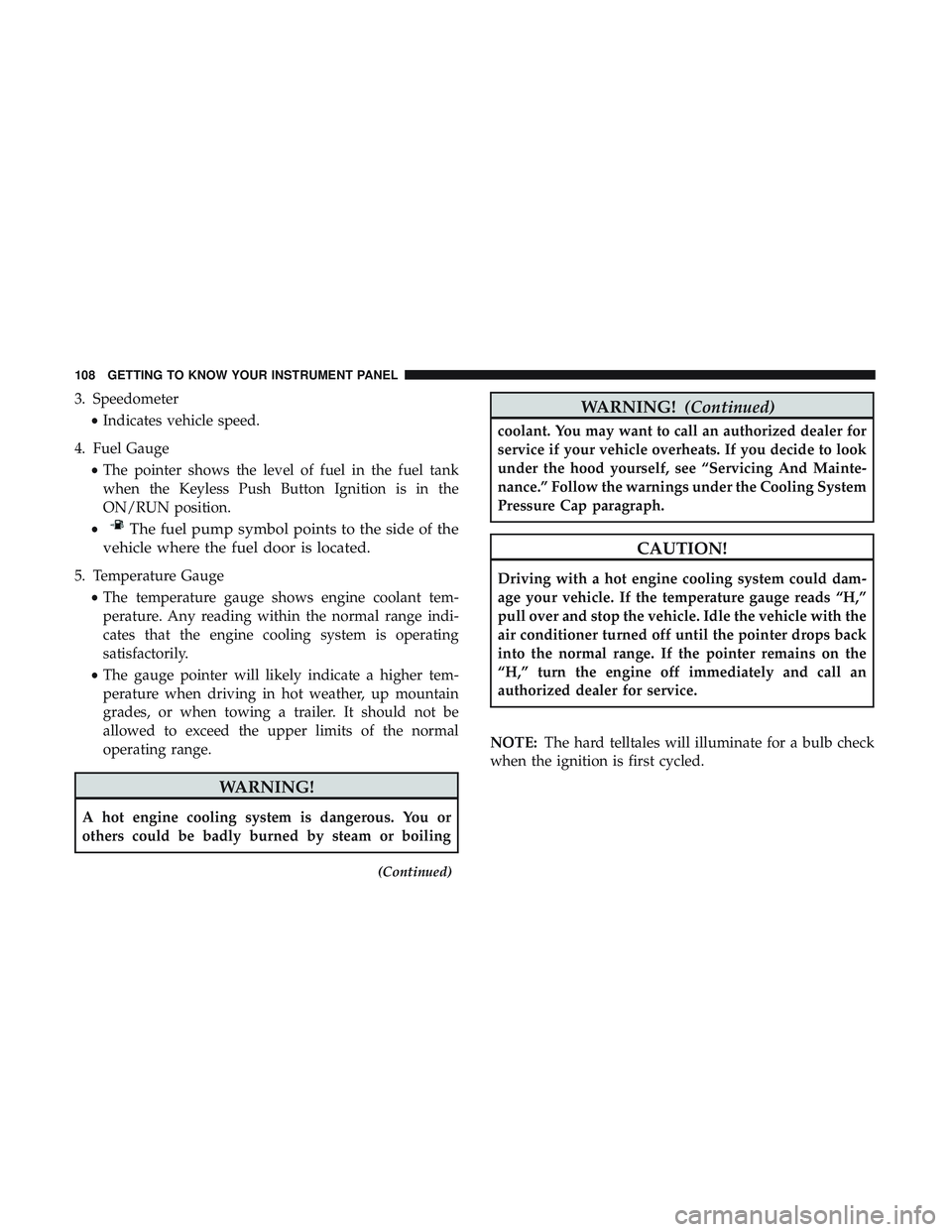
3. Speedometer•Indicates vehicle speed.
4. Fuel Gauge •The pointer shows the level of fuel in the fuel tank
when the Keyless Push Button Ignition is in the
ON/RUN position.
•
The fuel pump symbol points to the side of the
vehicle where the fuel door is located.
5. Temperature Gauge
•The temperature gauge shows engine coolant tem-
perature. Any reading within the normal range indi-
cates that the engine cooling system is operating
satisfactorily.
• The gauge pointer will likely indicate a higher tem-
perature when driving in hot weather, up mountain
grades, or when towing a trailer. It should not be
allowed to exceed the upper limits of the normal
operating range.
WARNING!
A hot engine cooling system is dangerous. You or
others could be badly burned by steam or boiling
(Continued)
WARNING! (Continued)
coolant. You may want to call an authorized dealer for
service if your vehicle overheats. If you decide to look
under the hood yourself, see “Servicing And Mainte-
nance.” Follow the warnings under the Cooling System
Pressure Cap paragraph.
CAUTION!
Driving with a hot engine cooling system could dam-
age your vehicle. If the temperature gauge reads “H,”
pull over and stop the vehicle. Idle the vehicle with the
air conditioner turned off until the pointer drops back
into the normal range. If the pointer remains on the
“H,” turn the engine off immediately and call an
authorized dealer for service.
NOTE: The hard telltales will illuminate for a bulb check
when the ignition is first cycled.
108 GETTING TO KNOW YOUR INSTRUMENT PANEL
Page 324 of 490
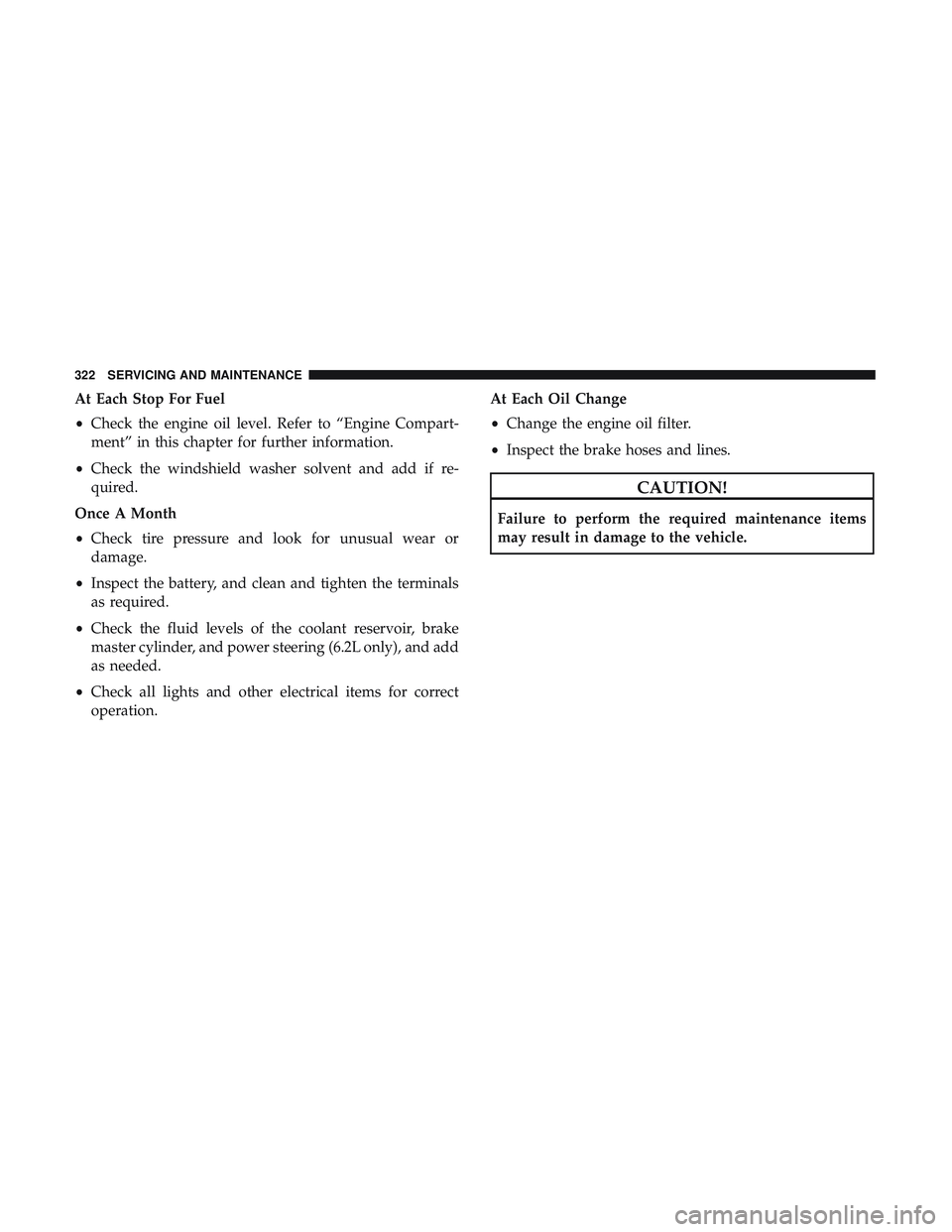
At Each Stop For Fuel
•Check the engine oil level. Refer to “Engine Compart-
ment” in this chapter for further information.
• Check the windshield washer solvent and add if re-
quired.
Once A Month
• Check tire pressure and look for unusual wear or
damage.
• Inspect the battery, and clean and tighten the terminals
as required.
• Check the fluid levels of the coolant reservoir, brake
master cylinder, and power steering (6.2L only), and add
as needed.
• Check all lights and other electrical items for correct
operation. At Each Oil Change
•
Change the engine oil filter.
• Inspect the brake hoses and lines.
CAUTION!
Failure to perform the required maintenance items
may result in damage to the vehicle.
322 SERVICING AND MAINTENANCE
Page 343 of 490
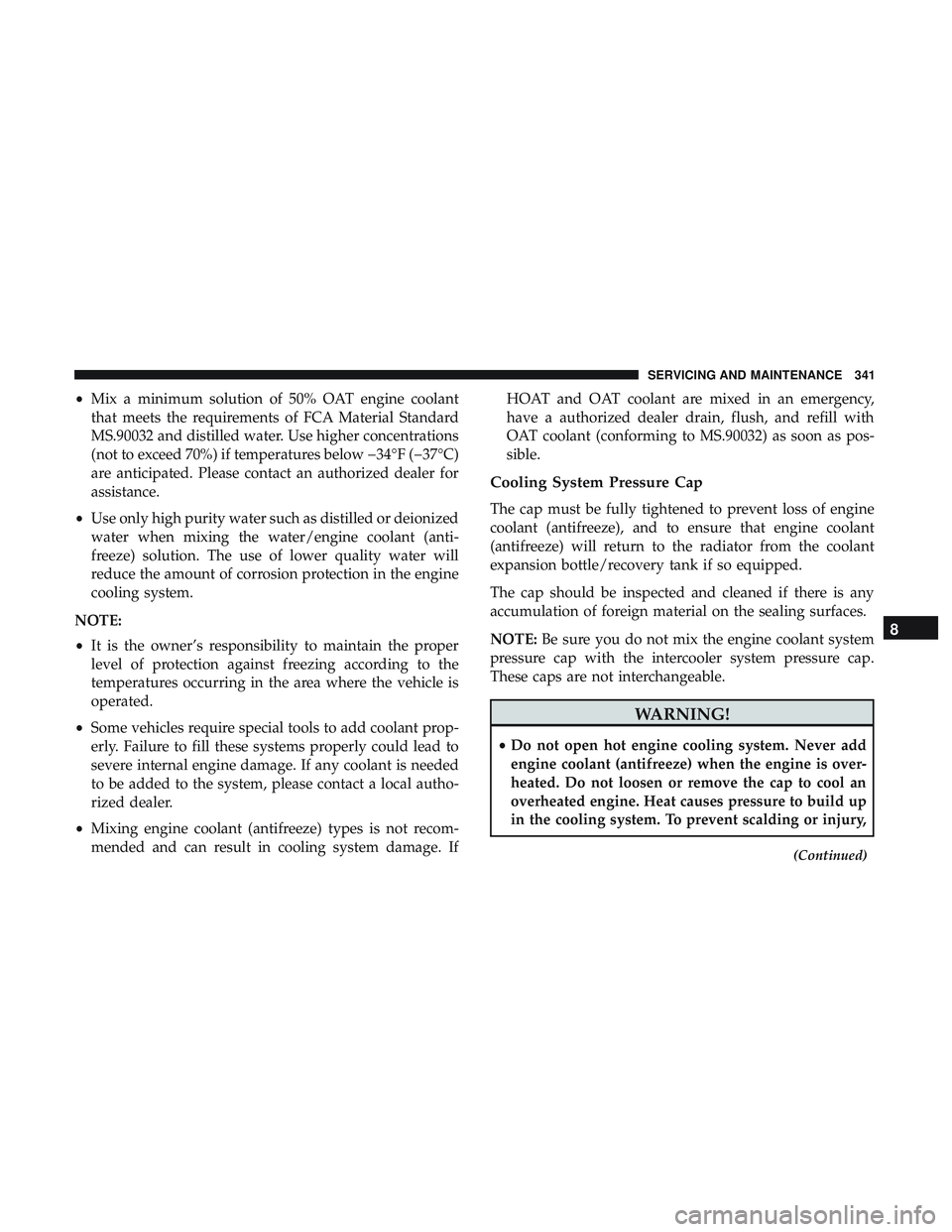
•Mix a minimum solution of 50% OAT engine coolant
that meets the requirements of FCA Material Standard
MS.90032 and distilled water. Use higher concentrations
(not to exceed 70%) if temperatures below �34°F (�37°C)
are anticipated. Please contact an authorized dealer for
assistance.
• Use only high purity water such as distilled or deionized
water when mixing the water/engine coolant (anti-
freeze) solution. The use of lower quality water will
reduce the amount of corrosion protection in the engine
cooling system.
NOTE:
• It is the owner’s responsibility to maintain the proper
level of protection against freezing according to the
temperatures occurring in the area where the vehicle is
operated.
• Some vehicles require special tools to add coolant prop-
erly. Failure to fill these systems properly could lead to
severe internal engine damage. If any coolant is needed
to be added to the system, please contact a local autho-
rized dealer.
• Mixing engine coolant (antifreeze) types is not recom-
mended and can result in cooling system damage. If HOAT and OAT coolant are mixed in an emergency,
have a authorized dealer drain, flush, and refill with
OAT coolant (conforming to MS.90032) as soon as pos-
sible.
Cooling System Pressure Cap
The cap must be fully tightened to prevent loss of engine
coolant (antifreeze), and to ensure that engine coolant
(antifreeze) will return to the radiator from the coolant
expansion bottle/recovery tank if so equipped.
The cap should be inspected and cleaned if there is any
accumulation of foreign material on the sealing surfaces.
NOTE:
Be sure you do not mix the engine coolant system
pressure cap with the intercooler system pressure cap.
These caps are not interchangeable.
WARNING!
• Do not open hot engine cooling system. Never add
engine coolant (antifreeze) when the engine is over-
heated. Do not loosen or remove the cap to cool an
overheated engine. Heat causes pressure to build up
in the cooling system. To prevent scalding or injury,
(Continued)
8
SERVICING AND MAINTENANCE 341
Page 344 of 490
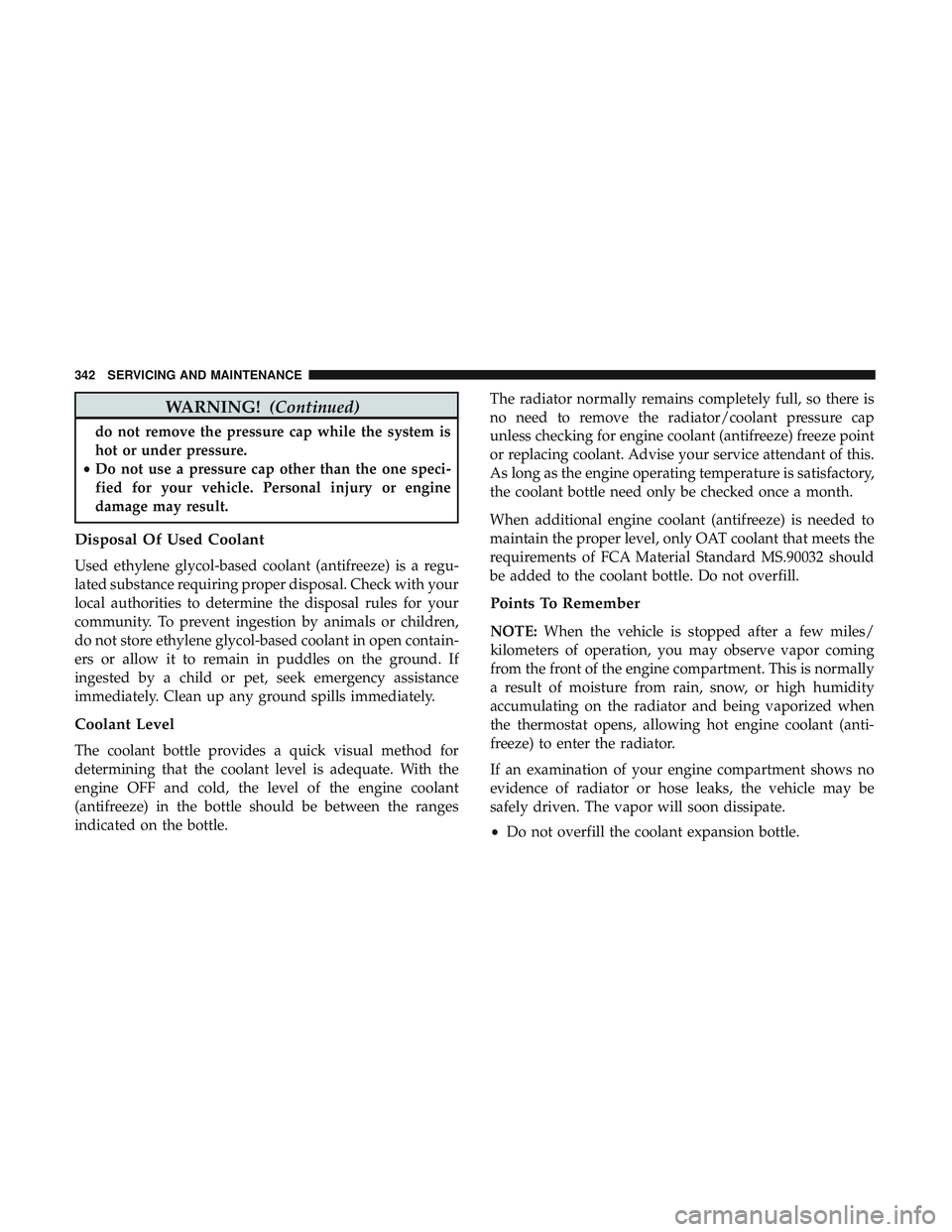
WARNING!(Continued)
do not remove the pressure cap while the system is
hot or under pressure.
• Do not use a pressure cap other than the one speci-
fied for your vehicle. Personal injury or engine
damage may result.
Disposal Of Used Coolant
Used ethylene glycol-based coolant (antifreeze) is a regu-
lated substance requiring proper disposal. Check with your
local authorities to determine the disposal rules for your
community. To prevent ingestion by animals or children,
do not store ethylene glycol-based coolant in open contain-
ers or allow it to remain in puddles on the ground. If
ingested by a child or pet, seek emergency assistance
immediately. Clean up any ground spills immediately.
Coolant Level
The coolant bottle provides a quick visual method for
determining that the coolant level is adequate. With the
engine OFF and cold, the level of the engine coolant
(antifreeze) in the bottle should be between the ranges
indicated on the bottle. The radiator normally remains completely full, so there is
no need to remove the radiator/coolant pressure cap
unless checking for engine coolant (antifreeze) freeze point
or replacing coolant. Advise your service attendant of this.
As long as the engine operating temperature is satisfactory,
the coolant bottle need only be checked once a month.
When additional engine coolant (antifreeze) is needed to
maintain the proper level, only OAT coolant that meets the
requirements of FCA Material Standard MS.90032 should
be added to the coolant bottle. Do not overfill.
Points To Remember
NOTE:
When the vehicle is stopped after a few miles/
kilometers of operation, you may observe vapor coming
from the front of the engine compartment. This is normally
a result of moisture from rain, snow, or high humidity
accumulating on the radiator and being vaporized when
the thermostat opens, allowing hot engine coolant (anti-
freeze) to enter the radiator.
If an examination of your engine compartment shows no
evidence of radiator or hose leaks, the vehicle may be
safely driven. The vapor will soon dissipate.
• Do not overfill the coolant expansion bottle.
342 SERVICING AND MAINTENANCE
Page 345 of 490
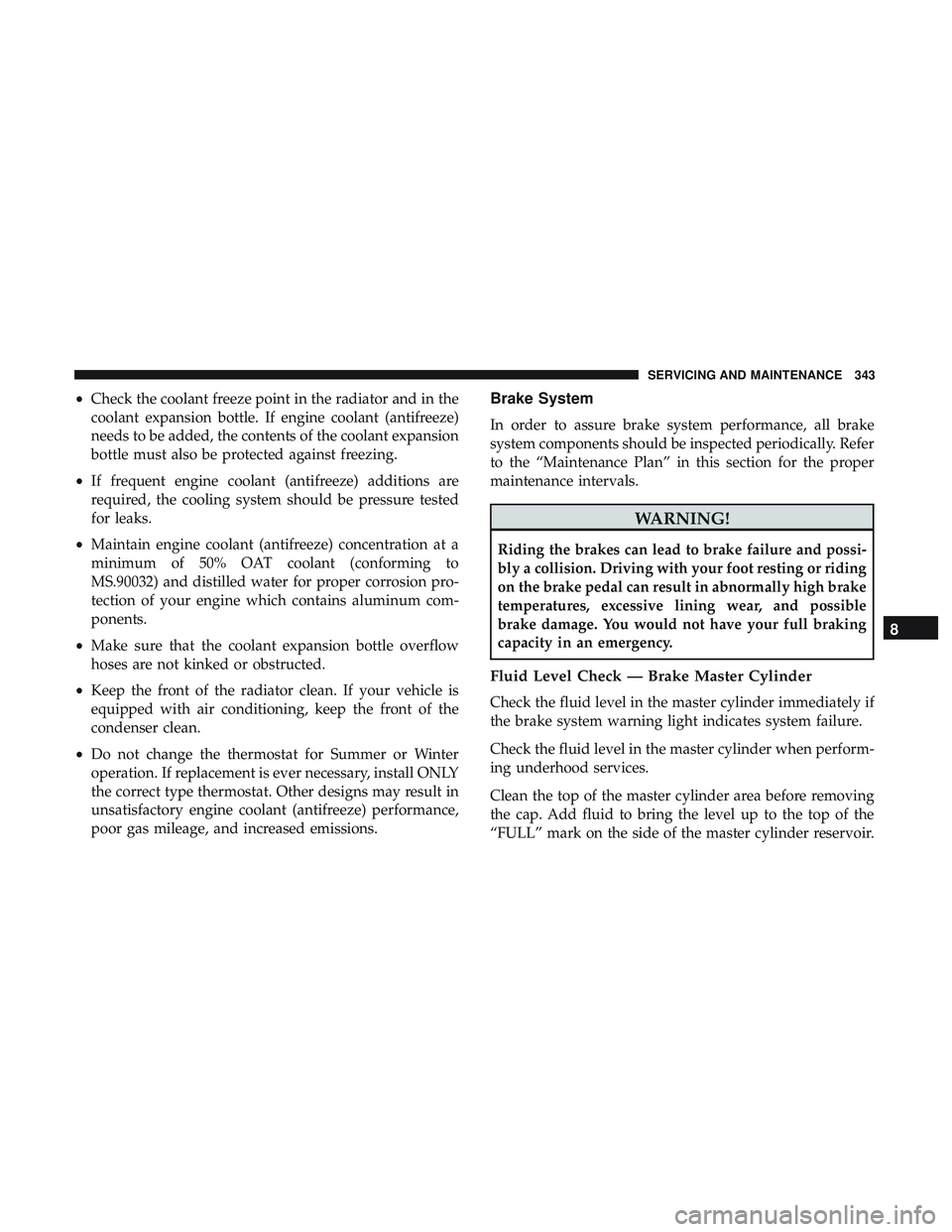
•Check the coolant freeze point in the radiator and in the
coolant expansion bottle. If engine coolant (antifreeze)
needs to be added, the contents of the coolant expansion
bottle must also be protected against freezing.
• If frequent engine coolant (antifreeze) additions are
required, the cooling system should be pressure tested
for leaks.
• Maintain engine coolant (antifreeze) concentration at a
minimum of 50% OAT coolant (conforming to
MS.90032) and distilled water for proper corrosion pro-
tection of your engine which contains aluminum com-
ponents.
• Make sure that the coolant expansion bottle overflow
hoses are not kinked or obstructed.
• Keep the front of the radiator clean. If your vehicle is
equipped with air conditioning, keep the front of the
condenser clean.
• Do not change the thermostat for Summer or Winter
operation. If replacement is ever necessary, install ONLY
the correct type thermostat. Other designs may result in
unsatisfactory engine coolant (antifreeze) performance,
poor gas mileage, and increased emissions.Brake System
In order to assure brake system performance, all brake
system components should be inspected periodically. Refer
to the “Maintenance Plan” in this section for the proper
maintenance intervals.
WARNING!
Riding the brakes can lead to brake failure and possi-
bly a collision. Driving with your foot resting or riding
on the brake pedal can result in abnormally high brake
temperatures, excessive lining wear, and possible
brake damage. You would not have your full braking
capacity in an emergency.
Fluid Level Check — Brake Master Cylinder
Check the fluid level in the master cylinder immediately if
the brake system warning light indicates system failure.
Check the fluid level in the master cylinder when perform-
ing underhood services.
Clean the top of the master cylinder area before removing
the cap. Add fluid to bring the level up to the top of the
“FULL” mark on the side of the master cylinder reservoir.
8
SERVICING AND MAINTENANCE 343
Page 386 of 490
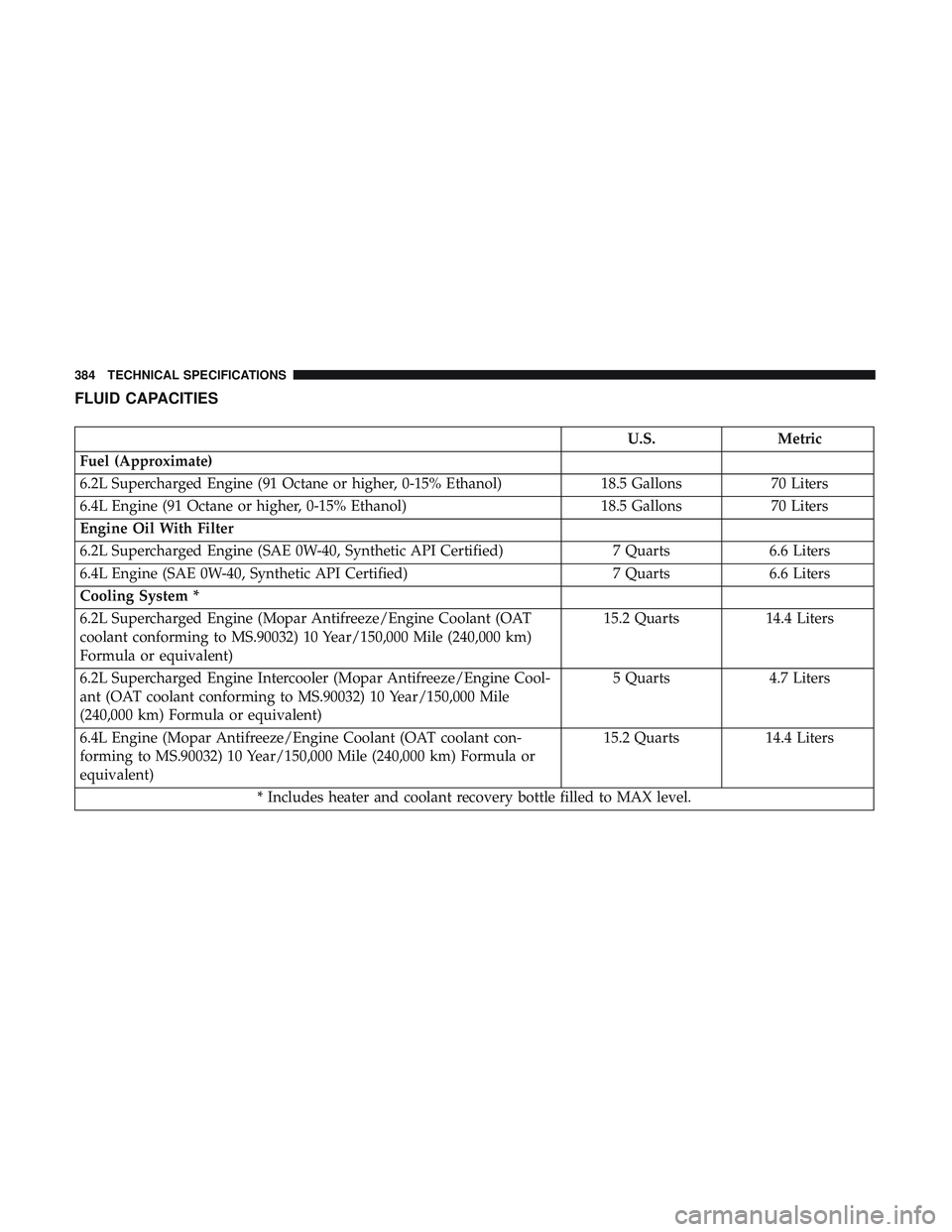
FLUID CAPACITIES
U.S.Metric
Fuel (Approximate)
6.2L Supercharged Engine (91 Octane or higher, 0-15% Ethanol) 18.5 Gallons70 Liters
6.4L Engine (91 Octane or higher, 0-15% Ethanol) 18.5 Gallons70 Liters
Engine Oil With Filter
6.2L Supercharged Engine (SAE 0W-40, Synthetic API Certified) 7 Quarts6.6 Liters
6.4L Engine (SAE 0W-40, Synthetic API Certified) 7 Quarts6.6 Liters
Cooling System *
6.2L Supercharged Engine (Mopar Antifreeze/Engine Coolant (OAT
coolant conforming to MS.90032) 10 Year/150,000 Mile (240,000 km)
Formula or equivalent) 15.2 Quarts
14.4 Liters
6.2L Supercharged Engine Intercooler (Mopar Antifreeze/Engine Cool-
ant (OAT coolant conforming to MS.90032) 10 Year/150,000 Mile
(240,000 km) Formula or equivalent) 5 Quarts
4.7 Liters
6.4L Engine (Mopar Antifreeze/Engine Coolant (OAT coolant con-
forming to MS.90032) 10 Year/150,000 Mile (240,000 km) Formula or
equivalent) 15.2 Quarts
14.4 Liters
* Includes heater and coolant recovery bottle filled to MAX level.
384 TECHNICAL SPECIFICATIONS
Page 476 of 490
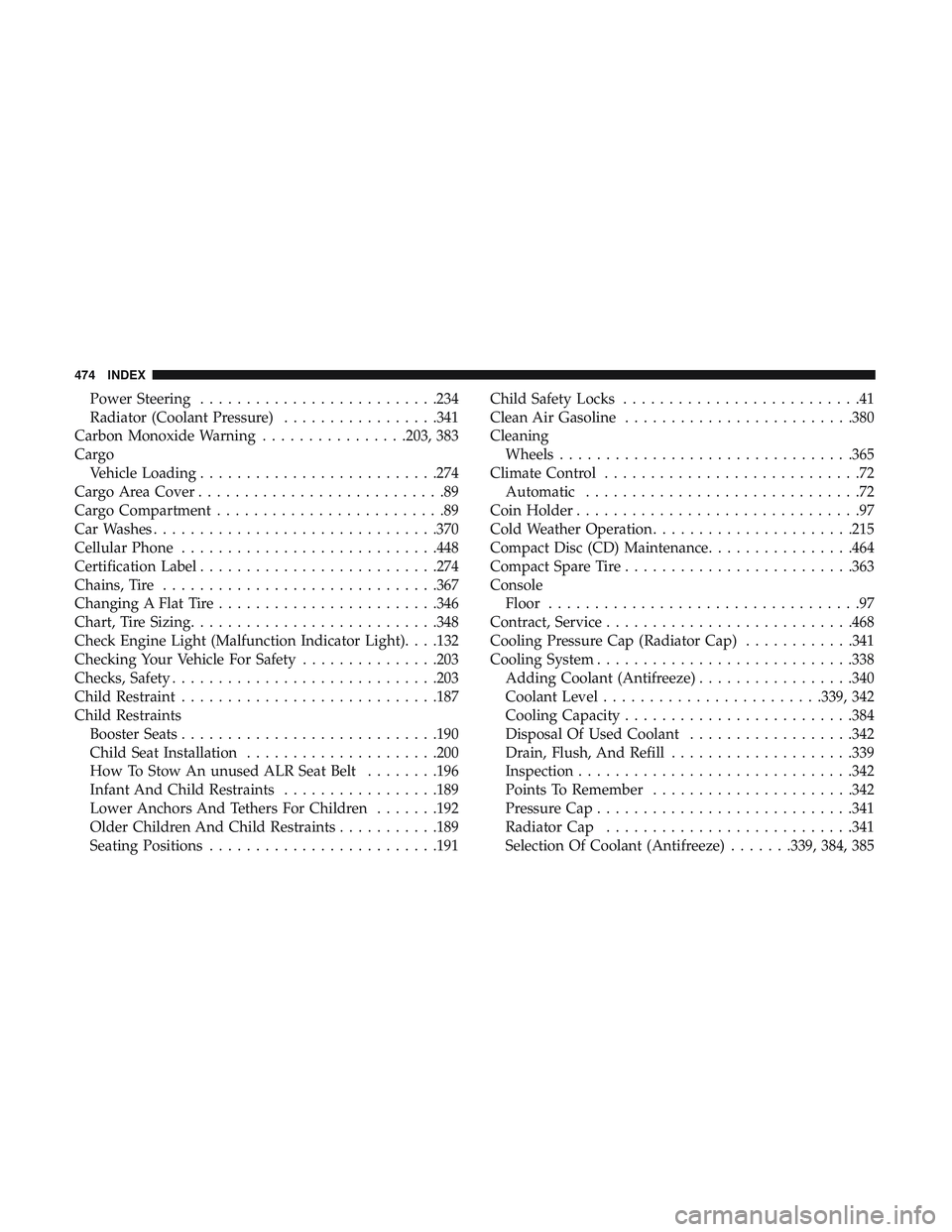
Power Steering..........................234
Radiator (Coolant Pressure) .................341
Carbon Monoxide Warning ................203, 383
Cargo Vehicle Loading ..........................274
Cargo Area Cover ...........................89
Cargo Compartment .........................89
Car Washes ...............................370
Cellular Phone ............................448
Certification Label ..........................274
Chains, Tire ............................. .367
Changing A Flat Tire ........................346
Chart, Tire Sizing .......................... .348
Check Engine Light (Malfunction Indicator Light). . . .132
Checking Your Vehicle For Safety ...............203
Checks, Safety ............................ .203
Child Restraint ............................187
Child Restraints Booster Seats ............................190
Child Seat Installation .....................200
How To Stow An unused ALR Seat Belt ........196
Infant And Child Restraints .................189
Lower Anchors And Tethers For Children .......192
Older Children And Child Restraints ...........189
Seating Positions ........................ .191Child Safety Locks
..........................41
Clean Air Gasoline ........................ .380
Cleaning Wheels ............................... .365
Climate Control ............................72
Automatic ..............................72
Coin Holder ...............................97
Cold Weather Operation ..................... .215
Compact Disc (CD) Maintenance ................464
Compact Spare Tire ........................ .363
Console Floor ..................................97
Contract, Service .......................... .468
Cooling Pressure Cap (Radiator Cap) ............341
Cooling System ............................338
Adding Coolant
(Antifreeze).................340
Coolant Level ........................339, 342
Cooling Capacity ........................ .384
Disposal Of Used Coolant ..................342
Drain, Flush, And Refill ....................339
Inspection ............................. .342
Points To Remember ..................... .342
Pressure Cap ............................341
Radiator Cap .......................... .341
Selection Of Coolant (Antifreeze) .......339, 384, 385
474 INDEX
Page 478 of 490
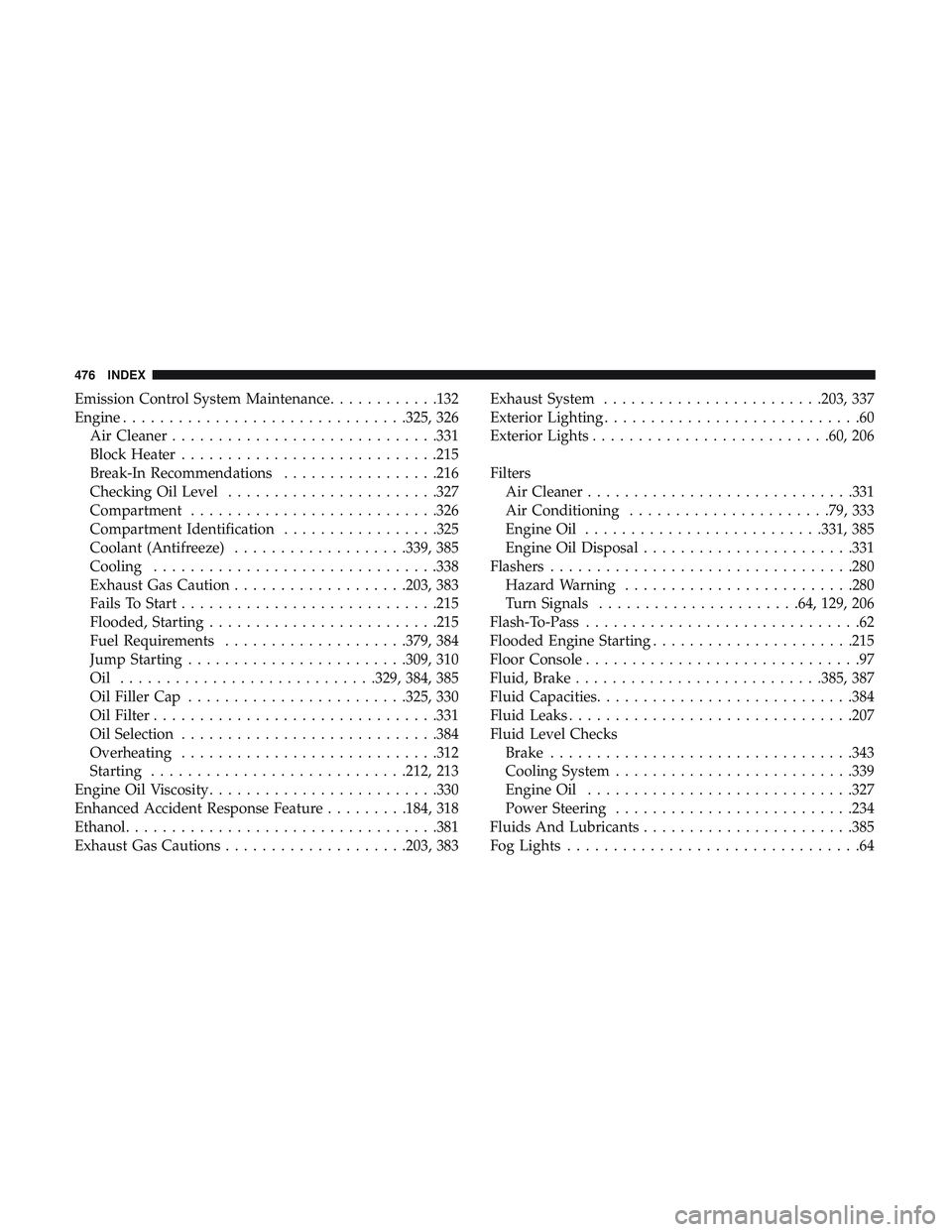
Emission Control System Maintenance............132
Engine ...............................325, 326
Air Cleaner ............................ .331
Block Heater ............................215
Break-In Recommendations .................216
Checking Oil Level .......................327
Compartment .......................... .326
Compartment Identification .................325
Coolant (Antifreeze) ...................339, 385
Cooling ...............................338
Exhaust Gas Caution ...................203, 383
Fails To Start ............................215
Flooded, Starting ........................ .215
Fuel Requirements ....................379, 384
Jump Starting ........................309, 310
Oil ............................329, 384, 385
Oil Filler Cap ........................325, 330
Oil Filter ...............................331
Oil Selection ............................384
Overheating ............................312
Starting ............................212, 213
Engine Oil Viscosity ........................ .330
Enhanced Accident Response Feature .........184, 318
Ethanol ................................. .381
Exhaust Gas Cautions ....................203, 383 Exhaust System
........................203, 337
Exterior Lighting ............................60
Exterior Lights ..........................60, 206
Filters Air Cleaner ............................ .331
Air Conditioning ..................... .79, 333
Engine Oil ..........................331, 385
Engine Oil Disposal .......................331
Flashers .................................280
Hazard Warning ........................ .280
Turn Signals ..................... .64,129,
206
Flash-To-Pass ..............................62
Flooded Engine Starting ..................... .215
Floor Console ..............................97
Fluid, Brake .......................... .385, 387
Fluid Capacities ............................384
Fluid Leaks ...............................207
Fluid Level Checks Brake .................................343
Cooling System ..........................339
Engine Oil ............................ .327
Power Steering ..........................234
Fluids And Lubricants .......................385
Fog Lights ................................64
476 INDEX